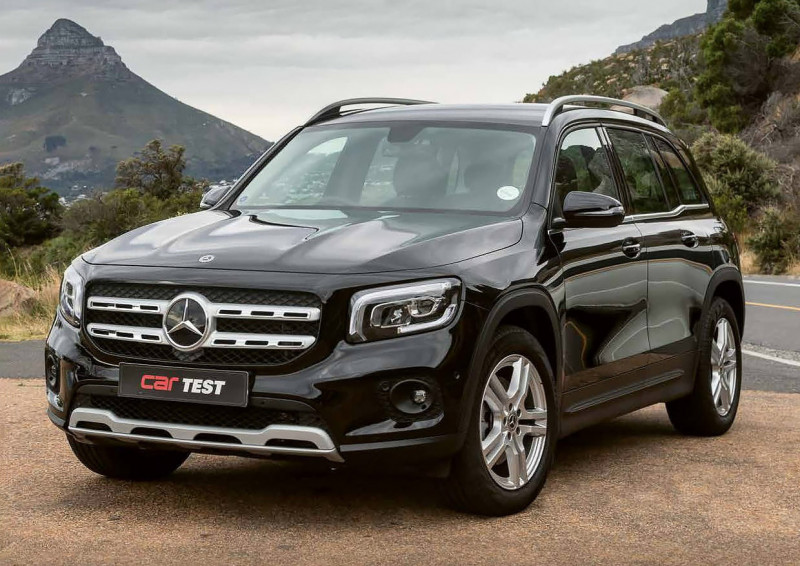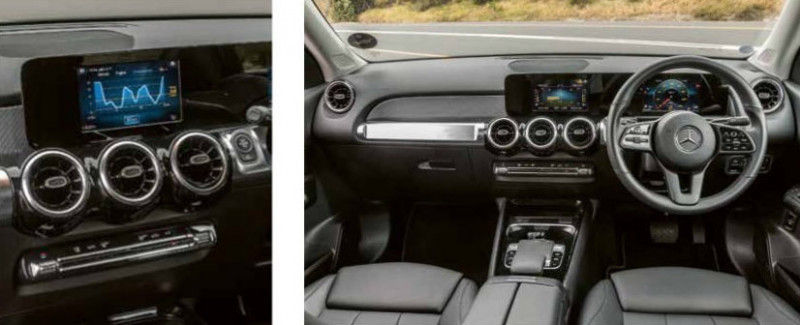2024 Mercedes-Benz GLB 220d 4Matic X247
With standout looks and school-run-smashing space, what’s a GLB if stuck between the GLA and GLC?
TEST — SANDWICH SQUEEZE

If one were to hazard a visit to less official so-called author-edited dictionaries, the general consensus seems to be anything pertaining to an in-betweener is terminally uncool. In the murky realm of keyboard cowboy cancel culture, particular disdain is reserved for individuals, occupations or organisations characterised by inferior standing that seem to simply exist to fulfil no particular purpose, or merely make up the numbers.

So it must have seemed for the product planners of the GLA (that first saw the light in 2014) and GLC (2016), who had likely rolled their eyes following the subsequent introduction of Mercedes’ Johnny-come- lately, middle-child GLB in 2020.With good reason. Although the GLB shares the platform of the A-Class-based GLA (albeit extended by 10 cm to stretch it to just 22 mm shy of the GLC), neither of its bookending siblings has the option of a third row of seats; it’s yours for an additional R20 200.
The GLB’s appearance is also more defined. No other GL-series Mercedes sports this stepped shoulder line at the foot of the C-pillar; and the upright grille, vertical headlamps and square wheel arches distinctly resemble the square-shaped Gelendewagen Luxus Kompaktklasse, or GLK, sold abroad from 2010 to 2015, but regrettably never locally. With a temporary suspension of disbelief, the GL prefix pays homage to the marque’s iconic, go-anywhere W460 Gelendewagen produced from 1979 until 1992.

With just 135 mm of ground clearance and, while nowhere near as capable off-road as the Gelendewagen – or ever conceived to be – the GLB nevertheless has permanent cockpit-adjustable all-wheel drive. In default mode, torque is distributed 80/20 front and rear, 70/30 in Sport mode and 50/50 in Off-road mode.
Propulsion comes courtesy of Mercedes’ ubiquitous twin-scroll turbodiesel 2,0-litre OM654 power unit. In this peak state of tune, it produces 140 kW at 3 800 r/min and 320 N.m between 1 600 and 2 400 r/min.
In South Africa, the GLB range comprises two engine-, drivetrain and specification options, starting from R990 950, separated by just R12 000-odd in price before any budget-busting luxury packages are piled on.
Our test unit, the 220d 4Matic, came in entry-level trim and was ironically dubbed Progressive grade, which is Mercedes-speak for bare-bones specification. To get an idea of the depths of the austerity, instead of the standard GLB equipment, it’s easier to list the optional inventory: wireless charging, on-board navigation, electrically folding mirrors, dualzone air conditioning, rear air vents, a large-diameter central infotainment display and adaptive cruise control – and more.
That leaves manually operated leather seats, a pair of roof rails, voice control, self-dipping LED headlamps, non-adaptive cruise control, wireless Android Auto/ Apple CarPlay, a powered tailgate, keyless entry and rear USB-C charging points as the 220d’s only noteworthy standard features.
If this spartan-for-the-price selection is puzzling, the interior is rather spacious. Locally, at least, Mercedes isn’t making much of its seven-seating ability (rightly so, as the spacial impracticalities inherent in three-row, four-door cars have been well documented), meaning it carries itself best as a five-seater. Second-row occupants – relieved of the burden of an additional row of passengers behind them – have the luxury of sliding a pew towards its rearmost position, as well as reclining the seat back into a business-class angle … admittedly, this is for an extra R6 100.
Other annoyances prevail. The minuscule graphic hidden away at the bottom-right of the infotainment screen indicating the chosen direction of the air channelled into the cabin towards the windshield, dashboard vents or footwells is no larger than a pinhead and will most certainly be problematic for visually challenged occupants.
Our test unit’s fan also elicited a troubling whirring noise when the air conditioning was on full, and when the plastics on the inner window shelves and Apillars were too firmly thumbed, they creaked. The selection of plastics is not exactly from the Maybach parts bin; those used for the door cards and glove box lid appeared bargain-basement and out of place in a R1 million car.
However, the GLB impressed on the road. The torquey 2-litre turbodiesel pulls strongly out of corners and sipped a miserly 5,1 litres during our standard 100-km fuel run comprising a mix of driving conditions and routes. The cherry on top of such exemplary manners is the absence of diesel clatter from the engine. It is so aurally inoffensive that only the indicated red line and torque characteristics reveal tell-tale clues to its oilburning nature. In fact, at motorway speeds, you’re more likely to notice the rumble from the tyres or the wind buffeting the wing mirrors than you are the engine.
There is more grip than the torque is able to overcome and, thanks to all-wheel drive, the traction on all surfaces is predictably abundant. This may just pose a threat to the GLB’s purpose.
TEST SUMMARY
All-wheel softroaders exist to tame not the Tankwa Karoo, but rather the snowy, sleeted tar of the perilous passes criss-crossing their continents of birth, where ground clearance is infrequently a challenge, but tractive ability an eternal non-negotiable. These threats are considerably less common in South Africa and for anyone reluctant to surrender R1 million for what is effectively a VW Tiguan sporting a fancier badge, the initial reaction is to ditch the AWD and opt for the petrol-driven GLB 250, which offers peppier performance and only marginally poorer fuel economy. However, this would push the price into seven-digit territory, suggesting the primary drawback of the entire similarly priced GLB line-up is that it fails to offer stand-out value.
It is also outshined by its rivals. A BMW X2 M35i will run rings around the Mercedes; the Lexus UX is more subtly sophisticated (although it is let down by its CVT); and the slightly more compact Volvo XC40 B5 AWD looks and drives better and saves you nearly R130 000. Will a cutesy countenance, willing engine and bountiful interior space at nearly a bar balance the needless all-wheel drive and a rep-spec interior? For the same reason the GLB fulfils the role of Mercedes’ midsize in-betweener so perfectly, it is difficult to imagine it as a main course.
All-wheel drive is an unnecessary indulgence, better spent on missing luxuries. Kudos if you’ve ever spotted one in traffic — Braam Peens
Very spacious for passengers, but rather pricey for the spec level — Peter Palm
01 Tame 17-inch alloys expose the 220d’s rep-spec status, but higher tyre sidewalls provide
better driving comfort. 02 Floor-height boot sill enables easy rear access. 03 MBUX interface
can be controlled by either touchscreen or touchpad. 04 Tiny seven-inch screens can be
upgraded to 10.25 inches as part of the R51 000 PremiumPackage
Price: R998 388
0-62mph 0–100 km/h: 8,17 seconds
Top speed: 217 km/h Power: 140 kW Torque: 400 N.m
CAR fuel index: 6,6 L/100 km CO2: 144 g/km
SPECIFICATIONS MERCEDES-BENZ GLB220D 4MATIC
ENGINE
- Cylinders: four, inline, transverse
- Fuel supply: electronic common-rail direct
- injection, turbocharged, diesel
- Bore/stroke: 82,0/92,3 mm
- Cubic capacity: 1 950 cm3
- Compression ratio: 15,5 to 1 1
- Valvegear: d-o-h-c, four valves per cylinder
ENGINE OUTPUT
- Max power ISO: 140 kW
- Power peak/Red line: 3 800/4 600 r/min
- Max torque: 400 N.m
- Torque peak: 1 600-2 600 r/min
TRANSMISSION
- Type: eight-speed dual-clutch
- 1st gear/2nd gear: 17,56 / 12,32 to 1
- 3rd gear/4th gear: 8,09 / 5,67 to 1
- 5th gear/6th gear: 4,12 / 3,23 to 1
- 7th gear/Top gear: 2,52 / 1,99 to 1
- Reverse gear: 14,75 to 1
- Final drive: 1,00 to 1
- Drive wheels: all
- Driver aids: ESC (electronic stability control), hill start
BRAKES
- Front: 330 mm ventilated discs
- Rear: 320 mm solid discs
- Hydraulics: ABS with EBD and EBA
WHEELS AND TYRES
- Tyre make: Pirelli Scorpion Verde
- Tyre size: 235/55 R18
- Spare – type and location: none, mobility kit
STEERING
- Type: rack and pinion, electric power assist
- Lock to lock: 2,7 turns
- Turning circle diameter: 11,7 m
SUSPENSION
- Front: independent, MacPherson struts, coil springs, anti-roll bar
- Rear: independent, multilink, coil springs, anti-roll bar
WARRANTY & SERVICE INTERVALS
- 2-year/unlimited km warranty
- 5-year/100 000 km maintenance plan
- Services according to on-board computer
PARTS PRICES*
- Oil filter: R4 055,20
- Air filter: R729,51
- Left headlamp: R22 324,48
- Left rear tyre: R3 339,29
- Windscreen: R6 347,40
- Brake pads (front set): R1 469,56
- Camchain (incl. tensioner): R5 162,41
- Total parts basket: R43 427,85
TEST RESULTS
Test conditions**: Ambient temp/barometric press: 27 ÅãC/1 026 hPa Test car’s odometer: 8 408 km
TOP SPEED
- Manufacturer’s figure: 217 km/h
BRAKING TEST
- Best/worst stop: 2,82/3,1
- Average of 10 stops/rating: 2,94/excellent
- Average stopping distance: 39,93 m
- 10 stops from 100 km/h measured in seconds.
FUEL CONSUMPTION
- Fuel tank: 60 litres
- Est. tank range (fuel index): 909 km
- Taxable CO2 rating: 144 g/km
PERFORMANCE FACTORS
- Power/mass: 81 W/kg
- Power/litre: 72 kW/litre
- Torque/litre: 205 N.m/litre
- Cabin noise level at idle: 41 dB
- Engine speed (at true 120 km/h in top gear): 1 823 r/min
FEATURES CHECKLIST
- Airbags: front/side/curtain/knee
- Air-con: climate
- Audio system: radio/auxin/USB/Bluetooth/Android Auto/Apple CarPlay
- Cruise control: standard
- Sat-nav: optional
- Park assist: standard, incl. camera
- Windows: all-electric
- Trip computer: standard
- Driver seat adjust: manual, incl. height
- Folding rear seat: 60:40 split
- Upholstery: leather Isofix anchorages: outer rear
- Steering adjust: rake + reach
- Steering audio controls: standard
- Tyre sensors: standard
- Wipers auto-on: standard
- Headlamps auto-on: standard Head-up display: optional
MATCH-UP
Mercedes-Benz GLB 220d 4Matic X247
Struggles to convince as a seven-seater or an off-roader; this is badge-driven nicheness to the nth degree, and most certainly bought with the heart, rather than the head.
- price: R998 388
- cyl/capac: 4/1 950 cm3
- power: 140 kW/3 800 r/min
- torque: 400 N.m/1 600–2 600 r/min
- gears/drive: 8/4
- 0–100 km/h: 8,17 sec
- top speed: 217 km/h
- fuel index: 6,6 L/100 km
- luggage capac: 570/1680 L
- serv/maint plan: M5/100 000 km
BMW X2 M35i F39
Neither the prettiest nor the most practical, but with 225 kW, there is some dynamic promise and for performance purposes, its AWD makes more sense than in the dieseldriven GLB
- price: R961 081
- cyl/capac: 4/1 995 cm3
- power: 225 kW/5 000–6 200 r/min
- torque: 450 N.m/1 750–4 500 r/min
- gears/drive: 8/4
- 0–100 km/h: 4,9 sec
- top speed: 241 km/h
- fuel index: 8,9 L/100 km
- luggage capac: 240/936 L
- serv/maint plan: M5/100 000 km
Lexus UX 250h F Sport
Lands fully loaded at almost R50k less than the GLB and includes adaptive dampers.Will not win a Grand Prix or destroy a Grade 5 4x4 course, but oozes the understated elegance the Merc craves.
- price: R947 500
- cyl/capac: 4/1 987 cm3
- power: 135 kW
- torque: 188+e N.m
- gears/drive: CVT/F
- 0–100 km/h: 8,5 sec
- top speed: 177 km/h
- fuel index: 5,4 L/100 km
- luggage capac: 192/832 L
- serv/maint plan: M7/105 000 km
USED OPTION [<2yrs]
Volvo XC60 B5 AWD More demonstrative of seven-digit purchasing power than an outright GLB rival, R5 short of a million for a near-new 2023 model buys you a palatial interior with a magic-carpet-like ride and an irrefutable sense of style.


